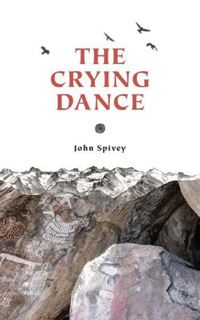Book Review: The Crying Dance
John Spivey’s Love Letter to the San Joaquin Valley
You can’t truly understand who you are, or why you do the things that you do, until you come to terms with your past. This is one of the central messages in a book called The Crying Dance written by S.B. resident John Spivey. It is a love letter to both the San Joaquin Valley and the people who once lived there. “The area is now like a third-world country,” Spivey said. “It is so poor, and the people are uneducated and devastated by the drought. [The book] is really a note of compassion and love to the area.”
Spivey, who grew up in the San Joaquin Valley two miles from the city of Woodsville, tells his story using four main characters: a Native American named Francisco; a Chinese man named Wu; a modern-day cowboy named J.R.; and Junípero Serra (yes, that Junípero Serra).

The book is the result of five years of research and toil. Spivey said he had the story on his mind for more than 50 years. When he was 12 years old, he read an article in his local newspaper about John Woods, a white settler who was killed in a gruesome manner by a group of Native Americans. One of these Native Americans, a member of the Yokuts tribe, was named Francisco. He became the inspiration for the novel and one of the main characters.
While Spivey said Francisco’s backstory was fictional, the incidents were based on real events. For example, the details of his life as a captive living at Mission San Luis Obispo de Tolosa, and the description of the death of his wife and child, were based on similar stories Spivey found in historical documents about the lives of Indians at the mission and in a book chronicling the oral history of the Yokut Indians.
In The Crying Dance, Francisco is kidnapped by soldiers when he is a young boy and taken to the mission. There he becomes a type of slave forced into hard labor and considered no more than property. People who try to escape are flogged or forced to wear hobbles. These types of threats don’t stop Francisco from escaping and seeking refuge with the Yokuts tribe. He finds peace with this group until white settlers, including John Woods, begin to encroach on Native American land and threaten their way of life.
Woods, whose character is based on the real man from Missouri, wants to settle the land, build houses, and create fenced-in homesteads. The Native Americans and the settlers come into conflict because of their opposing views about ownership of the land, and Francisco and Woods become enemies. “The relationship between Francisco and Woods really is the relationship between the white conquering world and Native Americans,” Spivey said.
Spivey has a link to this time in history: One of Spivey’s great-great grandfathers was an original settler to the San Joaquin area. However, when he was young, he saw no evidence of the conflicts that had occurred between the settlers and the Native Americans. “Growing up, there were no traces,” he said.
There are three main characters in the novel who live in different time periods, from the 1700s to the present. One of these characters is J.R., a Vietnam veteran with demons he can’t tame. Spivey said that the character is loosely based on his own father. “Though he wasn’t a cowboy, he was a Southerner who suffered not only PTSD from World War II [he was in Patton’s Third Army] but also a great deal of abuse similar to J.R. when he was growing up during the Depression in North Carolina. He died an alcoholic at 50.” He added, “You could say that with the book I was imagining redemption for him or for anyone in as much pain as him.”
According to Spivey, redemption for J.R. can only come through the acceptance of the idea that our ancestors and historical events are fused into our psychological makeup. “What people may call their thoughts and feelings may be relics of history,” he said. “We can’t erase it. The secret is to acknowledge it and where it affects you. Then you can choose.”
The character in the story who leads Francisco and J.R. on their journey to understanding and accepting themselves is Wu, a Chinese man and a practicing Buddhist. “Part of it for me is a view of the future of spiritualism where Buddhism, native shamanism, and Christianity push up against each other, and something emerges,” he said.
There are other characters in the book who are memorable, including J.R.’s girlfriend, Maria, and a truly wicked Junípero Serra. This book may inspire you to do some research to find out more about what happened during this time period in history.



